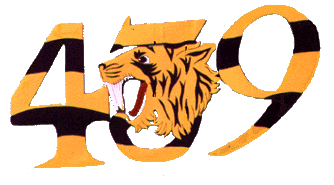|
History
of
 Squadron Squadron
  
Chapter
VII
The Advance to the Rhine
February
- March 1945
Later in the morning Buldern was attacked again and once more no bombing results could
be seen. F/Ls Shaver and Breck strafed a train, damaging the engine and four cars. On the way home from this sortie the pilots dived
down through a cloud break in an attempt to pinpoint their position. They found themselves on the southern edge of the Reichswald near
Goch, at 400 feet right over the battle area. Light flak immediately opened up with intense and accurate fire.
The Typhoon flown by
F/L L.C.
Shaver, the formation leader, was seen to be hit; it flicked on its back and dived into the ground. A forceful and
competent leader, Lyal was regarded as one of the finest pilots in the wing. He had done his first tour (136 sorties) in North Africa
and, since joining No.439 in November, had completed 66 trips over the lines. Both "A" and "B" Flights had lost their commanders to flak in little more than a week.
|

F/L
LC Shaver
Photo
439 Sqn Archives
|
Intentionally
left blank
|
F/L
W.G. Davis took "Babe" Swingler's place in charge of "A", and F/L
V.H.J. Le Gear succeeded Lyal Shaver in "B". F/L M.J. Whelan was posted in to complete the squadron establishment.
On the third wing show on the afternoon of 2 March each of the three squadrons was assigned to one of the sections Wesel Dorsten Borken
Bocholt. No. 439's two sections
bombed separately to the accompaniment of flak which, coupled with broken clouds, prevented observation of any results. The next morning the squadron sent out its first twelve plane formation under the leadership of Bill Davis. A big break in the clouds above
Haldern, on the Wesel Emmerich line, gave the pilots the opening for which they had been looking and one after the other the three
sections went down. Blue claimed three cuts and Yellow one more.
Then the clouds closed in and for over a week operations were almost at a standstill. Two sorties were attempted on 5 March, but the first could find no opening in the clouds and the second, encountering stronger winds than expected, had to be content with one solitary cut north east of
Coesfeld. Six cuts on eight operations was not a very high average for the first days of the month, but the pilots proved what they could achieve, given reasonable conditions, when they
equaled this score on the only operation carried out on 7 March.
|
|
One section led by F/O Adam Saunders blew a gap in the Rheine
Munsterline, while the other led by F/O Jack Roberts tallied five cuts near
Coesfeld. That was more like it! But on these laurels the squadron had to rest until
the 13th while the clouds gathered, scattered and closed in again. The weather, however, was not the sole cause of the operational inactivity of these March days that contrasted so sharply with February's
tempo. Typhoons were still very scarce and, although the squadron had its full complement of eighteen, it was warned that replacements could be obtained only for those with worn out engines.
Furthermore, with the approach of the date set for the crossing of the Rhine, cannon attacks on ground targets were temporarily forbidden the Tiffies so as to conserve aircraft for the large scale operations in plan. The pilots were naturally somewhat
"brassed off" when they were not allowed to fly on days when the weather was much better than that in which, a few weeks earlier, they had been expected to operate. Before March ended they had no cause to complain! Meanwhile they worked off surplus energy with volleyball and softball, which naturally was revived as spring drew near. Plans were soon under way for badminton, tennis, horseshoes, shooting, track and other sports. The Alps still attracted some of the happy pilots departing on leave; others returned to more familiar haunts in Britain. For the majority, however, the dud days meant a routine of sleep, eat, read, play cards, write letters
and carry out daily inspections of the aircraft.
  
Copyright
©1998-2016 Michael T. Melnick. All rights reserved
the
unofficial homepage of  Tiger
Squadron Tiger
Squadron
.
.
|
|